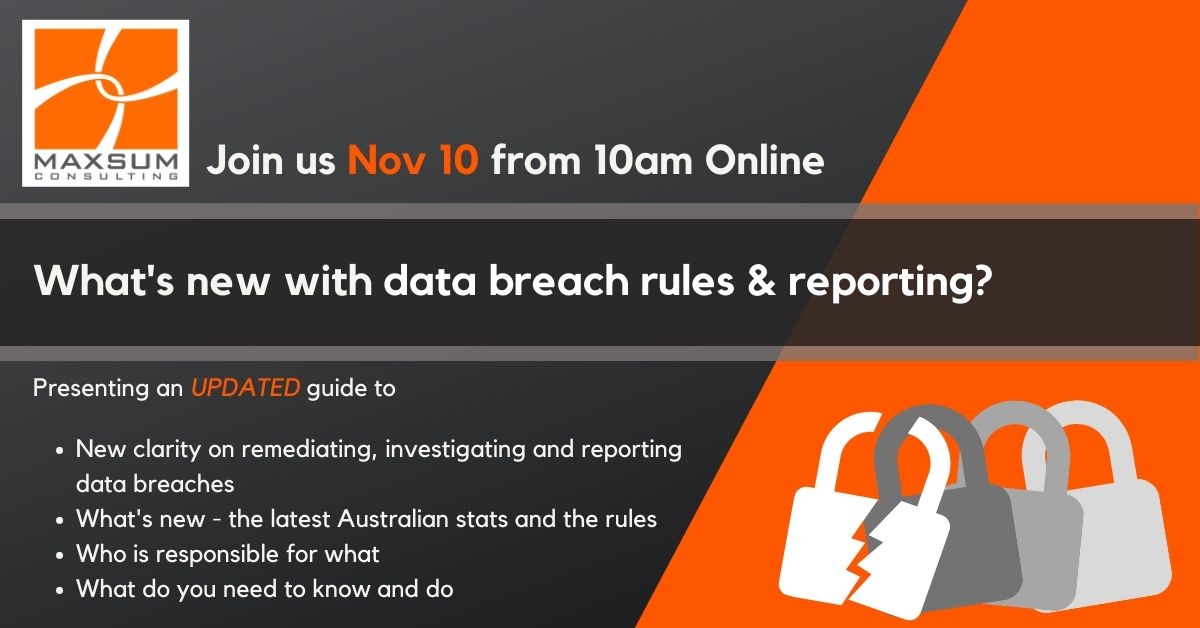[vc_row][vc_column][vc_column_text]
Find out what’s changed with…
Remediating, Investigating and Reporting on Data Breaches under the Notifiable Data Breaches Scheme in 2021 and beyond!
[/vc_column_text][vc_empty_space][vc_single_image image=”2704″ img_size=”full” alignment=”center” onclick=”custom_link” link=”https://teams.microsoft.com/registration/3o3je09Xi0eS4wAbE-8zbw,6fYAX5WNkEeJ5_XuWBtvsw,NKr_wNj6v02ZhiHFP92Cvw,H1Z_Y3UykEWtpO8gASXqhw,7LkZovPxHkCTOi-n4abmbA,lEE9vSIMV02kmlMEKxSpig?mode=read&tenantId=7be38dde-574f-478b-92e3-001b13ef336f”][vc_empty_space][vc_column_text]In 2018 Australia introduced the Notifiable Data Breaches Scheme, which mandated the reporting of eligible data breaches to the Office of the Australian Information Commissioner.
Since the introduction of the scheme there has remained some uncertainty around what constitutes an “eligible” data breach, what constitutes “remedial action”, and how the “likelihood of serious harm” can be interpreted.
Some 3 years on from its introduction and countless test cases later, the OAIC has provided some more definitive clarity around:
- The types of personal information that constitute “data” in a data breach reporting sense
- The kinds of remedial actions that do and do not negate reporting requirements
- The options for assessing and investigating breaches where there is a lack of evidence, like in the case of a ransomware attack
- The complexities and investigation requirements around Business Email Compromise investigations
- The human-error based data breaches that just won’t go away, and the new ones that have arisen thanks to COVID-19 and remote working
In this webinar, we will:
- Take you through the Office of the Australian Information Commissioner’s updated advice on each of these scenarios
- Take a deep dive into the latest data breach trend reports and examine the changing nature of the IT security threats causing those breaches, and
- Provide you with some advice on what you need to do next when you’ve experienced a data breach.
Join Maxsum’s Joe Ciancio, David Buchan and James Harper for a look at the stats, the case studies and a live Q&A.
[/vc_column_text][vc_empty_space][vc_single_image image=”2739″ img_size=”full” alignment=”center” onclick=”custom_link” link=”https://teams.microsoft.com/registration/3o3je09Xi0eS4wAbE-8zbw,6fYAX5WNkEeJ5_XuWBtvsw,NKr_wNj6v02ZhiHFP92Cvw,H1Z_Y3UykEWtpO8gASXqhw,7LkZovPxHkCTOi-n4abmbA,lEE9vSIMV02kmlMEKxSpig?mode=read&tenantId=7be38dde-574f-478b-92e3-001b13ef336f”][vc_empty_space][/vc_column][/vc_row]


